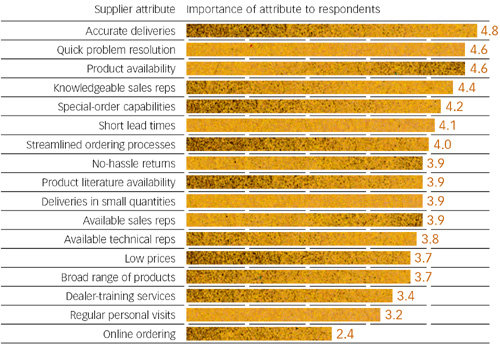At Smitty’s, Rhatican is comfortable with certain vendors making unaccompanied visits to contractors, but warns that it is best to have a solid and dependable relationship in place to ensure that the visit doesn’t backfire. “I’ve used vendor reps to call on customers and get the ball rolling in our direction,” he says. “But don’t send a rep that isn’t going to follow through and [does not] represent you well. You can shoot yourself in the foot if a contractor calls back and [was not impressed by the vendor].”
Regardless of who makes the contractor sales call, Weyerhaeuser’s Still suggests that all partners in the supply chain “have to look at the future” differently. “The people that are here today are the ones that did not always do things traditionally,” he says. “It is fine to be tested on doing things new and differently. It is a part of how we learn to be better.”
Forward Evolution As building material dealers and distributors continue to embrace such non-traditional roles as manufacturers and installers, the functions of product vendors also will continue to evolve. Forty-one percent of study respondents currently offer installed sales and 73 percent offer at least one of the seven manufactured components listed in the study. When considering only pro dealer lumberyard survey participants, the number of respondents offering manufactured components jumps to 91 percent (see “Dealer Components,” below).
“From the dealer side, services like manufacturing and installed sales continue to evolve,” explains Scheper. “Whether it’s framing or doors or windows or trim, we are always looking at installed sales [and manufacturing] opportunities, and I think the vendors hear that, and more and more programs will be built around those sales efforts.”
Derby agrees, explaining that Dean’s relationship with Greer, S.C.–based Guardian Building Products was vital to entering the insulation and after-paint installed sales markets. “Their support in training and equipment is what has gotten us into installed sales,” he says. “And that support has made us as successful as we are today.”
Probst says the distribution channel needs to look no further than production builders when searching for catalysts to shifting supply demands. “Obviously the trend is continued consolidation by the national builder, and the import to that are more changes affecting the pro dealer. Those builders are looking to rationalize and shorten their supply chain. If anyone in the channel is not adding value, their position is in jeopardy.” According to Probst, LP is even beginning to hear requests for liability protection for their distribution network. “Fresh on the scene is a legal document of product indemnity. The whole chain is asking for it because that is what the builders are asking for and striving to get. That’s something we didn’t see five years ago.”
Still adds that the more dealers and distributors venture into installed sales and manufacturing, the more they are going to need precision from manufacturers and their products. “We will have to provide them with a more targeted product that will fit those needs,” he says. “But it will be an opportunity to provide better buildings through better distribution, to provide a combination of products, systems, and delivery solutions that can take waste out, build a better home, and look better to the final customer.”
About the Survey The PROSALES Buying & Selling Practices Study was conducted by Readex Research, a nationally recognized independent research company based in Stillwater, Minn. The survey sample of 2,400 was selected by Northbrook, Ill.-based Omeda Communications and Readex from the list of 20,483 U.S.-based establishments (single locations of firms that may have multiple locations) to which PROSALES magazine circulates. Of the companies in the study, more than half are best described as building material dealers/lumberyards (52 percent), and an additional 22 percent are specialty dealers/distributors. A smaller proportion (11 percent) are building material wholesaler establishments, while 4 percent are considered two-step distributors. Only one record per location was sampled to avoid double-counting establishments. Data was collected via mail survey from Oct. 4 to Nov. 17, 2004. The survey was closed for tabulation with 912 usable responses—a 38 percent response rate. The margin of error for percentages based on 912 usable responses is+/- 3.2 percent at the 95 percent confidence level. For a copy of the full study results via e-mail, contact senior editor Chris Wood at cwood@hanleywood.com.

